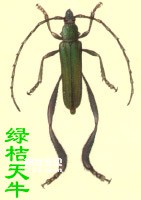The green orange beetle is also known as the twig beetle and the flute beetle. Distributed in Sichuan. Damage to citrus plants such as sweet oranges, red tangerines and lemons. The newly hatched larvae first damage the twigs of the orange tree, causing them to dry up, and then gradually bore down into the big branches. In severe cases, the branches are hollowed out, with holes everywhere, and the ground under the crown is covered with insect excrement, which weakens the growth of the tree and reduces the yield sharply.

The adult body is 22-26 mm long and about 6 mm wide. It is dark green and shiny, with a green ventral surface covered with silvery gray hairs. The head is green, the eyes are dark green, the head has fine dots, and there is a smooth and smooth patch between the base of the lip and the forehead. Slightly depressed area. The 1st, 2nd, and 3rd sections of the tentacles are dark purple, and the remaining sections are dark green. The stalk segments are blunt and rounded, with blunt spines at the ends of segments 5-10, and the terminal segments of the antennae slightly extend out of the insect body. The prothoracic segment is green, almost equal in length and width, with punctures and fine wrinkles. Both the scutellum and the scutellum are green, and the ends of the lateral spinous processes are blunt. The scutes are green, smooth and shiny. The elytra are carefully carved. There are 5 segments visible in the abdomen of female worms and 6 segments in the abdomen of male worms. The feet are green, and the tibia segment of the hind foot is particularly flat, wider than the enlarged part of the tibia segment of the middle foot.
The eggs are oblong, slightly larger in the middle, yellow-green, 4.5-5 mm long.
Mature larvae are milky white or light yellow. The body length is 35-40 mm, and the anterior thoracic segment is 7-8 mm. There are 3 pairs of thorax and feet, and there are movers on segments 2-9 on the dorsal and ventral surfaces of the thorax and abdomen; there are four brown spots on the front edge of the pronotum, arranged horizontally, and the two middle ones are longer.
The pupa is milky white or light yellow, 25-40 mm long and 5-6 mm wide. The wing bud reaches the 5th abdominal segment, 8 segments are clearly visible on the abdomen, stomata can be seen on both sides of segments 1-7, and there are dense and uneven short brown stinging hairs on the back.
The life habit is one generation per year, with adults appearing in May and blooming in July-August. After emergence, the adults stay in the pupa chamber for several days and then crawl out. They usually mate and lay eggs at noon. The eggs are laid at the bifurcation between the petioles of the tender green twigs and the branches, about 10 cm from the tips of the branches. At this time, the young branches will die. The egg stage is about 20 days. The newly hatched larvae burrow into the twigs and first feed upwards by 0.5-1 cm, then turn downwards to feed on the main branches, drilling rows of fecal ventilation holes every 5-20 cm. August is the peak period of damage caused by newly hatched larvae.
Prevention and treatment methods
(1) When adults appear, kill them.
(2) When newly hatched larvae infest young branches, timely pruning of insect-eaten dry branches is the key measure to prevent the insect from continuing to cause damage.
animal tags:
We created this article in conjunction with AI technology, then made sure it was fact-checked and edited by a Animals Top editor.